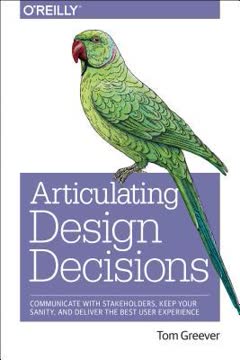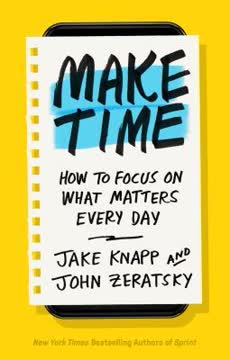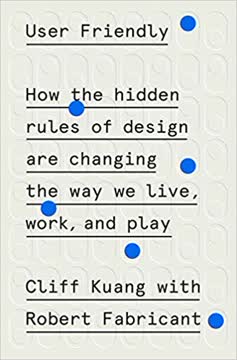Key Takeaways
1. Our artificial world can be redesigned for the better
Almost everything I see is artificial, and almost everything artificial has been designed.
Our world is designed. From the clothes we wear to the governments we live under, nearly everything in our lives is artificial - created by human design. This realization is both empowering and challenging. It means that the systems and structures causing harm to people and the planet are not immutable; they can be changed. However, because these artificial constructs have been in place for so long, they often seem natural and unchangeable to most people.
Path dependency impacts change. The decisions made in the past heavily influence our present circumstances and future possibilities. This concept explains why societal change can be so difficult - we are constrained by the momentum of historical choices. However, understanding path dependency also reveals opportunities for intervention. By identifying key decision points and reimagining alternatives, we can chart new courses for society.
Areas of artificial design include:
- Physical objects (buildings, products, infrastructure)
- Social constructs (laws, economic systems, customs)
- Belief systems (religions, ideologies, cultural values)
- Organizational structures (governments, corporations, institutions)
2. Measure what truly matters to people, not just economic indicators
Today's world is dominated by the remaining traces of modernism, where technology, science, and economics rule.
Rethink measurement systems. Our current methods of assessing societal progress, particularly economic indicators like GDP, fail to capture what truly matters to people's lives. These abstract numerical measurements often lead to decisions that prioritize short-term economic gains over long-term human and environmental well-being. We need new, more holistic ways of measuring success that account for factors such as happiness, health, education, and environmental sustainability.
Qualitative measures matter. While quantitative data is important, qualitative information - stories, experiences, and subjective assessments - provides crucial context and meaning. Dashboards that visually represent multiple factors can offer a more comprehensive view of complex systems than single numerical values. By combining quantitative and qualitative data, we can create a richer understanding of societal health and progress.
Alternative measurement approaches:
- Well-being indices (e.g., Genuine Progress Indicator, Human Development Index)
- Multi-factor dashboards (e.g., UN Sustainable Development Goals)
- Qualitative assessments (e.g., community narratives, case studies)
- Psychological measures (e.g., happiness surveys, quality of life assessments)
3. Embrace a circular economy to eliminate waste and promote sustainability
Waste must go away. Here is where the design profession can play a major role by switching to materials that are sustainable and by designing for repair, regeneration, and reuse.
Redesign for circularity. The current "take-make-waste" linear economic model is unsustainable and destructive to the environment. A circular economy, inspired by natural systems, aims to eliminate waste by designing products and systems for reuse, repair, and regeneration. This approach not only reduces environmental impact but can also create new economic opportunities and improve resource efficiency.
Systemic change is necessary. Implementing a circular economy requires reimagining entire systems of production, consumption, and disposal. It involves changes in product design, business models, consumer behavior, and waste management infrastructure. While challenging, this transition is essential for creating a sustainable future.
Key principles of circular design:
- Design out waste and pollution
- Keep products and materials in use
- Regenerate natural systems
- Use renewable and biodegradable materials
- Create modular, repairable products
- Develop product-as-service business models
4. Shift from human-centered to humanity-centered design
Designers, governments, and industry must broaden the notion of design from human centered to humanity centered.
Expand design's scope. While human-centered design has improved many products and services, it often fails to consider broader societal and environmental impacts. Humanity-centered design expands this perspective to encompass all of humanity, including future generations, as well as the entire ecosystem. This approach recognizes that humans are part of a complex, interconnected system and that design decisions have far-reaching consequences.
Collaborate with communities. Humanity-centered design emphasizes working with communities rather than designing for them. This collaborative approach ensures that solutions are culturally appropriate, address real needs, and empower local people. Designers should act as facilitators and mentors, providing resources and expertise while respecting local knowledge and agency.
Principles of humanity-centered design:
- Consider long-term, systemic impacts
- Design for equity and inclusivity
- Prioritize environmental sustainability
- Engage diverse stakeholders in the design process
- Recognize and respect cultural differences
- Balance individual and collective needs
5. Technology should serve humanity, not the other way around
Technology has too much control over our lives. We have to change the entire fundamentals of technology to ensure that machines and technology are the servants of people, not the other way around.
Reorient technological development. Much of our current technology is designed with little consideration for its impact on human well-being or the environment. We need to shift our approach to technological development, prioritizing human needs and values over pure efficiency or profit. This means creating technologies that enhance human capabilities and improve quality of life, rather than technologies that dominate or replace human activity.
Design for human flourishing. Technology should be designed to support human strengths and compensate for weaknesses, not to replace human skills entirely. This approach, sometimes called "intelligence amplification" or "IA" rather than "AI," focuses on creating tools that work in harmony with human cognition and creativity. By doing so, we can create more meaningful and fulfilling work experiences and avoid the pitfalls of technological unemployment.
Guidelines for human-centered technology:
- Prioritize user control and agency
- Design for transparency and explainability
- Support human decision-making rather than replacing it
- Enhance human creativity and problem-solving
- Respect privacy and personal data
- Consider potential misuse and unintended consequences
6. Small, incremental changes can lead to significant societal improvements
The way to scale up is to scale down.
Embrace incremental progress. Large-scale societal changes are often difficult to implement due to resistance, complexity, and unforeseen consequences. Instead of attempting sweeping reforms, focus on small, manageable improvements that can be implemented and tested quickly. These incremental changes, when accumulated over time, can lead to significant transformations.
Modular design enables flexibility. By breaking large systems into smaller, modular components, we can create more adaptable and resilient solutions. This approach allows for easier updates, replacements, and customizations to meet changing needs. It also enables more localized, context-specific implementations of broader ideas.
Benefits of incremental, modular approaches:
- Reduced risk and resistance to change
- Faster implementation and feedback cycles
- Easier adaptation to local contexts
- More opportunities for learning and improvement
- Greater resilience to failures or setbacks
- Increased potential for widespread adoption
7. Human behavior is the key challenge in addressing global issues
Human behavior is the most critical aspect of today's difficulties.
Understand behavioral barriers. Many of the world's most pressing problems, from climate change to social inequality, are rooted in human behavior. Technical solutions alone are insufficient; we must address the psychological, social, and cultural factors that shape human actions and decisions. This requires a deep understanding of cognitive biases, social dynamics, and cultural influences.
Design for behavior change. By applying insights from psychology, behavioral economics, and other social sciences, we can create interventions that encourage more sustainable and equitable behaviors. This might involve redesigning physical environments, crafting effective communication strategies, or developing incentive systems that align individual actions with collective goals.
Strategies for promoting positive behavior change:
- Make sustainable choices the default option
- Use social norms and peer influence
- Provide immediate feedback and rewards
- Remove barriers to desired behaviors
- Tell compelling stories and use vivid imagery
- Leverage existing habits and routines
- Create supportive social and physical environments
Last updated:
FAQ
What's Design for a Better World about?
- Design's Influence: The book explores how design shapes our artificial world and its implications for sustainability and humanity. It highlights that almost everything we see is designed, influencing behavior and the environment.
- Core Themes: Donald A. Norman organizes the book around three main themes: meaningful design, sustainable practices, and humanity-centered approaches, addressing critical issues affecting our lives and the planet.
- Call for Change: Norman advocates for a transformation in design philosophy to prioritize human well-being and ecological health, suggesting that rethinking design can address pressing global challenges.
Why should I read Design for a Better World?
- Unique Perspective: The book offers a fresh perspective on the role of design in shaping societal values and environmental outcomes, encouraging critical thinking about daily interactions with products and systems.
- Actionable Insights: Norman provides practical strategies for creating designs that are functional and beneficial to society and the environment, making it a valuable resource for designers and policymakers.
- Engaging Writing: The accessible and engaging narrative, supported by real-world examples, makes complex topics understandable and relatable.
What are the key takeaways of Design for a Better World?
- Artificial World: The book emphasizes that our world is largely artificial and designed, shaping behaviors and societal structures, empowering individuals to question and change systems.
- Meaningful Design: Norman stresses the need for designs that communicate effectively and resonate with people's values, using understandable language and relatable examples.
- Sustainability Focus: Advocating for sustainable practices and a circular economy, the book highlights designing for longevity and minimal waste to benefit the environment and society.
What is the difference between human-centered design and humanity-centered design in Design for a Better World?
- Individual vs. Ecosystem Focus: Human-centered design focuses on individual users, while humanity-centered design includes the entire ecosystem, acknowledging interconnectedness.
- Broader Issues: Humanity-centered design addresses systemic issues like equity and environmental impact, considering long-term societal and planetary effects.
- Guiding Principles: Norman outlines five principles for humanity-centered design, including solving core issues and involving communities, aiming for designs that benefit all humanity.
How does Design for a Better World address climate change?
- Root Causes: Norman argues climate change is a symptom of deeper systemic issues, emphasizing the need to address unsustainable design practices and economic models.
- Collective Action: The book advocates for collective efforts to change behaviors and practices contributing to climate change, involving individuals, businesses, and governments.
- Design's Role: Design is seen as crucial in mitigating climate change by creating sustainable and environmentally friendly products and systems.
What is the circular economy, and how is it discussed in Design for a Better World?
- Circular Economy Defined: It is an economic model emphasizing reuse, repair, and regeneration of materials to minimize waste, contrasting with the traditional linear economy.
- Design Principles: Norman outlines principles like minimizing waste, keeping products in use, and regenerating natural systems, guiding sustainable product design.
- Implementation Challenges: The book discusses difficulties in transitioning to a circular economy, including business resistance and the need for new training and education.
What is the concept of humanity-centered design in Design for a Better World?
- Expanded Focus: Humanity-centered design considers broader implications on all people and the environment, seeking equitable, sustainable, and culturally relevant solutions.
- Community Involvement: Emphasizes involving communities in the design process, leading to more meaningful and effective outcomes.
- Systemic Issues: Aims to tackle systemic issues like inequality and environmental degradation, prioritizing the well-being of all individuals.
How does Design for a Better World propose to democratize design?
- Community Empowerment: Advocates for empowering communities to actively participate in the design process, ensuring their voices are heard and needs met.
- Collaborative Methods: Highlights participatory and co-design methods involving stakeholders in decision-making, leading to more relevant solutions.
- Inclusive Process: Emphasizes breaking down barriers between experts and laypeople, promoting innovative solutions reflecting diverse perspectives.
What are the main challenges in implementing sustainable design practices according to Design for a Better World?
- Resistance to Change: Companies often hesitate to adopt sustainable practices due to fears of increased costs and potential sales loss, rooted in profit-focused models.
- System Complexity: Modern supply chains and production processes' interconnected nature complicates implementing changes without disruption.
- Education Need: There's a pressing need for designers to be educated on sustainability and circular design principles, requiring a shift in design education.
What is the significance of the "incremental modular design" approach in Design for a Better World?
- Approach Defined: Involves breaking down large projects into smaller, manageable modules for incremental development and implementation.
- Benefits: Allows flexibility and adaptability, encouraging experimentation and learning from failures, leading to continuous improvement.
- Application: Useful in addressing complex "wicked problems," enabling iterative testing and refinement for effective solutions.
What role does human behavior play in the challenges discussed in Design for a Better World?
- Behavior Complexity: Human behavior is complex and influenced by numerous factors, making it difficult to predict responses to design changes.
- Change Resistance: People often resist changing behaviors, even when recognizing the need, hindering sustainable practice adoption.
- Education Importance: Emphasizes education and awareness to help individuals understand the impact of their choices, fostering solutions resonating with values.
What are the best quotes from Design for a Better World and what do they mean?
- “Almost everything artificial has been designed.”: Highlights that our environment is shaped by design, influencing behaviors and structures, empowering change.
- “We live in a world designed by people.”: Emphasizes designers' responsibility to create products and systems positively impacting society and the environment.
- “Design must change from being unintentionally destructive to being intentionally constructive.”: Advocates redefining design practices to focus on sustainability and humanity-centered approaches.
Review Summary
Design for a Better World receives mixed reviews, with an average rating of 3.58/5. Readers appreciate Norman's influential status and the book's broad concepts on sustainability and human-centered design. However, many criticize its execution, finding it repetitive, verbose, and lacking actionable insights. Some praise its wide-ranging topics, while others feel it's outdated and fails to provide concrete solutions. The book's formatting and readability are also criticized. Overall, opinions vary greatly, with some finding it insightful and others disappointed.
Similar Books










Download PDF
Download EPUB
.epub digital book format is ideal for reading ebooks on phones, tablets, and e-readers.






